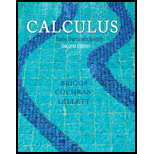
Explain why or why not Determine whether the following statements are true and give an explanation or counterexample.
- a. A function could have the property that f(−x) = f(x), for all x.
- b. cos (a + b) = cos a + cos b, for all a and b in [0, 2π].
- c. If f is a linear function of the form f(x) = mx + b, then f(u + v) = f(u) + f(v), for all u and v.
- d. The function f(x) = 1 − x has the property that f(f(x)) = x.
- e. The set {x: |x + 3| > 4} can be drawn on the number line without lifting your pencil.
- f. log10(xy) = (log10 x)(log10 y)
- g. sin−1 (sin (2π)) = 0
a.
Whether the given statement is true and give an explanation or a counter example.
Answer to Problem 1RE
The given statement is true.
Explanation of Solution
Given:
The given statement is “A function could have a property that
Calculation:
Consider the function
Now, check whether the above mentioned function satisfies the property
Therefore, the statement is true.
b.
Whether the given statement is true and give an explanation or a counter example.
Answer to Problem 1RE
The statement is false.
Explanation of Solution
Given:
The given identity is “
Calculation:
Take
Similarly, calculate the right hand side of the identity as follows.
That is,
Therefore, the statement is false.
c.
Whether the given statement is true and give an explanation or a counter example.
Answer to Problem 1RE
The statement is false.
Explanation of Solution
Given:
The given statement is “If
Calculation:
Take
The right hand side of equation
And, the left hand side of equation
Thus,
Therefore, the statement is false.
d.
Whether the given statement is true and give an explanation or a counter example.
Answer to Problem 1RE
The statement is true.
Explanation of Solution
Given:
The given statement is “The function
Calculation:
Consider the function
Calculate
Therefore, the statement is true.
e.
Whether the given statement is true and give an explanation or a counter example.
Answer to Problem 1RE
The statement is false.
Explanation of Solution
Given:
The given statement is “The set
Calculation:
The given set
Therefore, the set
Therefore, the statement is false.
f.
Whether the given statement is true and give an explanation or a counter example.
Answer to Problem 1RE
The statement is false.
Explanation of Solution
Given:
The given statement is “The equation,
Calculation:
Take,
Similarly, calculate the right hand side of the equation as shown below.
Then,
Therefore, the statement is false.
g.
Whether the given statement is true and give an explanation or a counter example.
Answer to Problem 1RE
The statement is true.
Explanation of Solution
Given:
The given statement is “The equation,
Calculation:
Consider
Then, compute the following.
Thus,
Therefore, the statement is true.
Want to see more full solutions like this?
Chapter 1 Solutions
Calculus: Early Transcendentals (2nd Edition)
Additional Math Textbook Solutions
Calculus, Single Variable: Early Transcendentals (3rd Edition)
Thomas' Calculus: Early Transcendentals (14th Edition)
University Calculus: Early Transcendentals (3rd Edition)
Precalculus
Precalculus: Concepts Through Functions, A Unit Circle Approach to Trigonometry (4th Edition)
- Algebra & Trigonometry with Analytic GeometryAlgebraISBN:9781133382119Author:SwokowskiPublisher:Cengage
 Linear Algebra: A Modern IntroductionAlgebraISBN:9781285463247Author:David PoolePublisher:Cengage Learning
Linear Algebra: A Modern IntroductionAlgebraISBN:9781285463247Author:David PoolePublisher:Cengage Learning Elements Of Modern AlgebraAlgebraISBN:9781285463230Author:Gilbert, Linda, JimmiePublisher:Cengage Learning,
Elements Of Modern AlgebraAlgebraISBN:9781285463230Author:Gilbert, Linda, JimmiePublisher:Cengage Learning,  Algebra: Structure And Method, Book 1AlgebraISBN:9780395977224Author:Richard G. Brown, Mary P. Dolciani, Robert H. Sorgenfrey, William L. ColePublisher:McDougal Littell
Algebra: Structure And Method, Book 1AlgebraISBN:9780395977224Author:Richard G. Brown, Mary P. Dolciani, Robert H. Sorgenfrey, William L. ColePublisher:McDougal Littell



